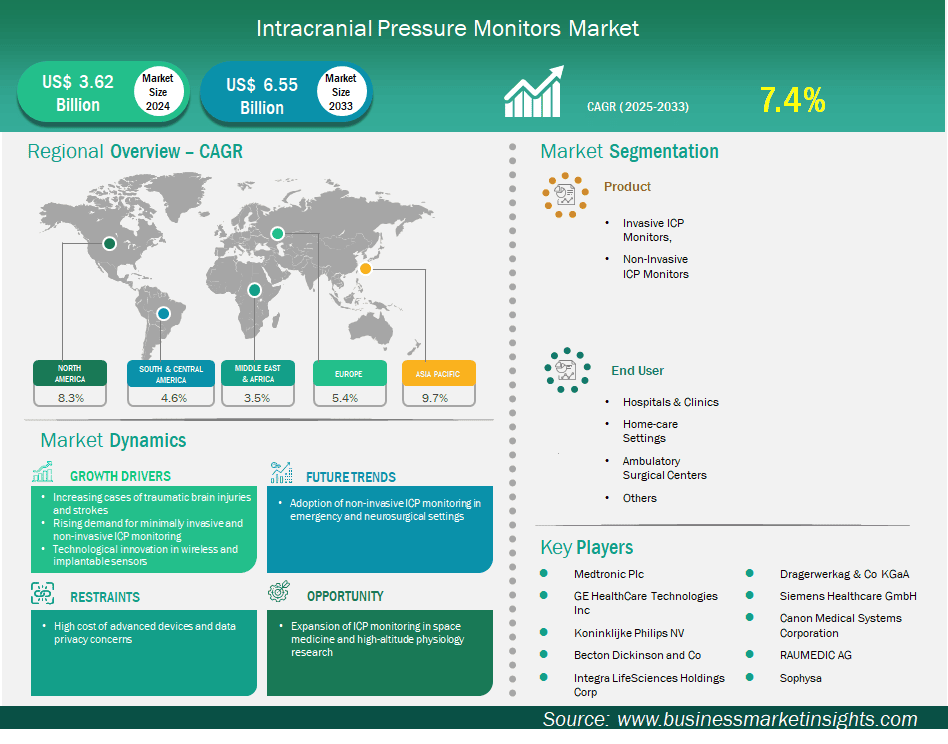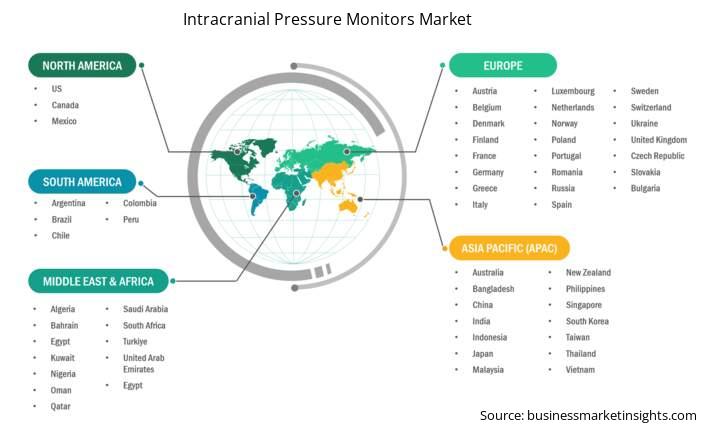Intracranial Pressure Monitors Market Outlook (2022-2033)
No. of Pages: 200 | Report Code: BMIPUB00031765 | Category: Life Sciences
No. of Pages: 200 | Report Code: BMIPUB00031765 | Category: Life Sciences
The intracranial pressure monitors market size is expected to reach US$ 6,550.94 million by 2033 from US$ 3,620.53 million in 2024. The market is estimated to record a CAGR of 7.4% from 2025 to 2033.
The global intracranial pressure monitors market is experiencing significant growth driven by increasing cases of traumatic brain injuries and strokes, rising demand for minimally invasive and non-invasive ICP monitoring, technological innovation in wireless and implantable sensors. Intracranial pressure monitors encompass invasive ICP monitors, non-Invasive ICP monitors. The marketplace for ICP monitors, is driven by an increase in the global prevalence of neurological disorders and traumatic brain injuries in addition to a rapidly growing elderly population that is at even greater risk of these conditions. Invasive methods are what currently leads the way in the marketplace which can require putting a sensor or catheter directly inside the brain or inside the spaces around the brain (like external ventricular drainage or micro transducer systems), because they have characteristics of great accuracy, but even more importantly they can drain excess CSF around the brain. Yet, there is a scope to less invasive and non-invasive technologies. Non-invasive techniques are just now becoming established as an alternative for monitoring ICP, including transcranial doppler ultrasonography and optic nerve sheath diameter, which provide significant benefits to patients by attenuating risks associated with invasive monitoring (such as infection, haemorrhage or catheter malfunction), and could not be timelier to provide patients with information about ICP dynamics and trends while also being less uncomfortable.

Key segments that contributed to the derivation of the Intracranial Pressure Monitors market analysis are product, application, and end user.
Increasing Cases of Traumatic Brain Injuries and Strokes Driving Intracranial Pressure Monitors Market
The rising global incidence of traumatic brain injuries (TBIs) and strokes is the main driving force behind the market for ICP monitors. TBIs, which include road traffic accidents, falls and violence, are one of the leading causes of death and disability globally. Together, they lead to millions of new cases every year. One of the most common, sometimes life-threatening complications of TBIs is increased ICP, a consequence of swelling or bleeding, which may impede adequate blood flow to the brain, leading to a secondary brain injury and potentially fatal consequences. Similarly, strokes especially haemorrhagic strokes like intracerebral haemorrhages or subarachnoid haemorrhages may lead to increased pressures in the cranial cavity due to bleeding and swelling followed by an increase in ICP. In both cases, ICP monitoring provides sustained and accurate monitoring to identify elevations to dangerous levels so timely, sometimes life-saving interventions can be made (e.g., fluid and medication interventions or possibly neurosurgical decompression) to improve survival and neurological outcomes.
Expansion of Intracranial Pressure (ICP) Monitoring into Space Medicine and High-altitude Physiology Research Devices
The extension of intracranial pressure (ICP) monitoring into space medicine and high-altitude physiology research is a promising opportunity for expansion of the ICP monitors market going forward. As long duration spaceflights can lead to an array of conditions in astronauts including Spaceflight Associated Neuro-ocular Syndrome (SANS) (involving vision impairment and ocular changes), the impetus is to develop, utilize and study non- or minimally non-invasive means of monitoring ICP for the unique and at times restrictive environment of space. The exact cause of the implications of spaceflight on ocular and neuro function remain unclear, but the most substantiated hypothesis at present ties Spaceflight-Associated Neuro-ocular Syndrome (SANS) to altered fluid shifts or increased ICP in microgravity. To monitor the neuro-ocular health of astronauts and to move toward effective countermeasures, ICP monitoring will inevitably be paramount to understanding the pathophysiology of SANS in long-duration spaceflight, and the potential for contributing to effective countermeasures further validates the need for monitoring of ICP in long-duration spaceflight. Further, continued research into altitude exposure and high-altitude cerebral edema (HACE) (a severe and lethal type of acute mountain sickness, including brain swelling and increased ICP) may also benefit from new non-invasive sensing modalities for monitoring ICP (in a more precise, portable, and valid manner).
This specialized demand of new approaches for ICP monitoring fosters innovation, and means a demand for technology that transcends simple, traditional ICP monitoring. Many implantable ICP monitors, while highly accurate, are invasive, and current non-invasive ICP monitors, are subject to many scrutinies over reliability and accuracy. Therefore, demand exists for new technologies that are non-invasive, flexible, robust, compact, and can measuring ICP continuously for a long duration of time without risk of failure, or in some cases, conflicting influences. The data also recovered from these extreme environments can support improved insights into the cerebral dynamics of fluids, and cerebral pressure regulation under unusual states of physiological health, and may lead to striking gains in methodologies for responding to circumstantial demands on address pathophysiology and morbidity in both neurocritical care purposes on the ground.
The intracranial pressure monitors market is classified according to products into invasive ICP monitors, non-Invasive ICP monitors. The invasive ICP monitors segment led the market in 2024 and beyond. Invasive intracranial pressure (ICP) monitors occupy the biggest segment of the market, due to their unmatched accuracy and reliability, which is critical for guiding life-saving interventions in a neurocritical care setting. External ventricular drainage (EVD), the gold standard for ICP monitoring, provides direct and real-time access to measure the pressure in the brain's ventricles, and has the unique capacity to drain cerebral spinal fluid (CSF) to actively reduce elevated ICP. While transducing intraparenchymal monitors also offer high degrees of accuracy, the clinical benefit of EVD is that the device can be recalibrated after positioning. Therefore, in the acute care of a neurological emergency (such as severe traumatic brain injury, or stroke) where timely and accurate ICP data is needed to mitigate the threat of secondary brain injury or irreversible neurological deficits, the certainty and direct nature of invasive methods provide greater benefits to clinicians than the risk of infectious complications or haemorrhage, making these methods essential.
By end user, the market is segmented into hospitals and clinics, home-care Settings, ambulatory surgical centers, others. The hospitals and clinics segment held the largest share of the market in 2024. Invasive ICP monitors require trained neurosurgical teams, sterile conditions, and advanced operating room capabilities, which exist only in hospital settings. Hospitals see high volumes of patients with serious neurologic issues like traumatic brain injury, intracerebral haemorrhage, and hydrocephalus, where continuous, minute-by-minute ICP assessment is essential to diagnosing, determining intervention, and forecasting resulting outcomes.
Intracranial Pressure Monitors Market Report Highlights
Report Attribute
Details
Market size in 2024
US$ 3,620.53 Million
Market Size by 2033
US$ 6,550.94 Million
Global CAGR (2025 - 2033) 7.4%
Historical Data
2022-2023
Forecast period
2025-2033
Segments Covered
By Product
By End User
Regions and Countries Covered
North America
Europe
Asia-Pacific
South, Central America
Middle East, Africa
Market leaders and key company profiles
The "Intracranial Pressure Monitors Market Size and Forecast (2021–2031)" report provides a detailed analysis of the market covering below areas:

The geographical scope of the intracranial pressure monitors market report is divided into five regions: North America, Asia Pacific, Europe, Middle East & Africa, and South & Central America. The Intracranial Pressure Monitors market in Asia Pacific is expected to grow significantly during the forecast period.
Asia Pacific intracranial pressure monitors market includes China, Japan, India, South Korea, Australia, Bangladesh, New Zealand, Philippines, Singapore, Indonesia, Taiwan, Malaysia, Vietnam, and the rest of Asia Pacific. Firstly, the region has a considerable increase in the prevalence of neurological disorders such as traumatic brain injuries (TBIs) and strokes, and an increasing geriatric population susceptible to these disorders. Together with the improvements in healthcare systems, increasing healthcare expenditure, and the rising awareness amongst clinicians and the public of the need for immediate interventions in brain injury cases, will only elevate the demand for new ICP monitoring devices. In addition, the increasing demand for non-invasive monitoring and technological advancements that will assist in the adoption of ICP monitoring will also help boost the growth in this region.
Within Asia Pacific, particular countries will have a considerable influence on this growth. For example, China is a rapidly growing market for ICP monitoring fuelled by its population, increasing healthcare expenditure, increasing prevalence of neurological disorders, and sports-related head injuries. As well as this, China's shift towards non-invasive monitoring methods and its heavy R&D investment in monitoring equipment and performance will continue to grow this segment. India is also continuing to grow in size, as evidenced through its large population, increasing prevalence of neurological disorders such as strokes and TBIs (often as a result of road traffic accidents or falls), and perhaps most importantly, its increasing awareness of the benefits of ICP monitoring.
The intracranial pressure monitors market is evaluated by gathering qualitative and quantitative data post primary and secondary research, which includes important corporate publications, association data, and databases. A few of the key developments in the Intracranial Pressure Monitors market are:
The Intracranial Pressure Monitors Market is valued at US$ 3,620.53 Million in 2024, it is projected to reach US$ 6,550.94 Million by 2033.
As per our report Intracranial Pressure Monitors Market, the market size is valued at US$ 3,620.53 Million in 2024, projecting it to reach US$ 6,550.94 Million by 2033. This translates to a CAGR of approximately 7.4% during the forecast period.
The Intracranial Pressure Monitors Market report typically cover these key segments-
The historic period, base year, and forecast period can vary slightly depending on the specific market research report. However, for the Intracranial Pressure Monitors Market report:
The Intracranial Pressure Monitors Market is populated by several key players, each contributing to its growth and innovation. Some of the major players include:
The Intracranial Pressure Monitors Market report is valuable for diverse stakeholders, including:
Essentially, anyone involved in or considering involvement in the Intracranial Pressure Monitors Market value chain can benefit from the information contained in a comprehensive market report.